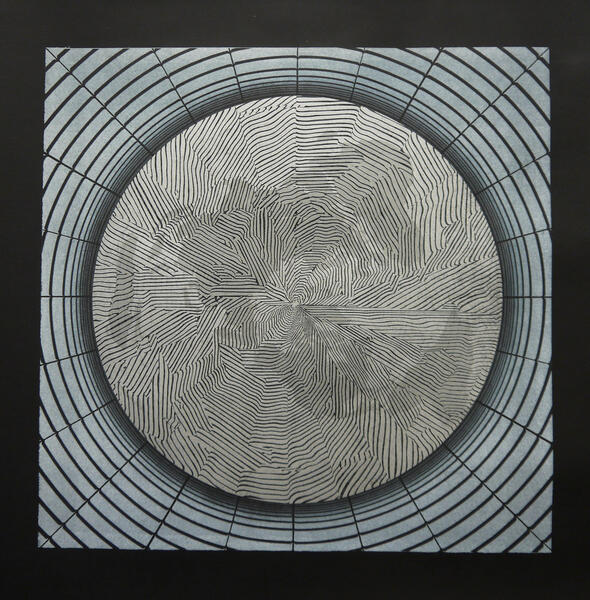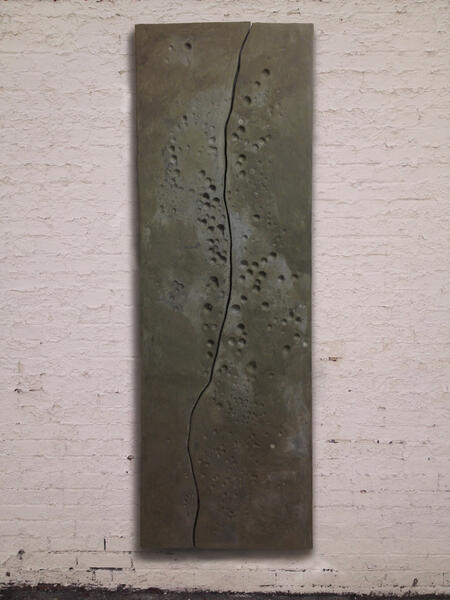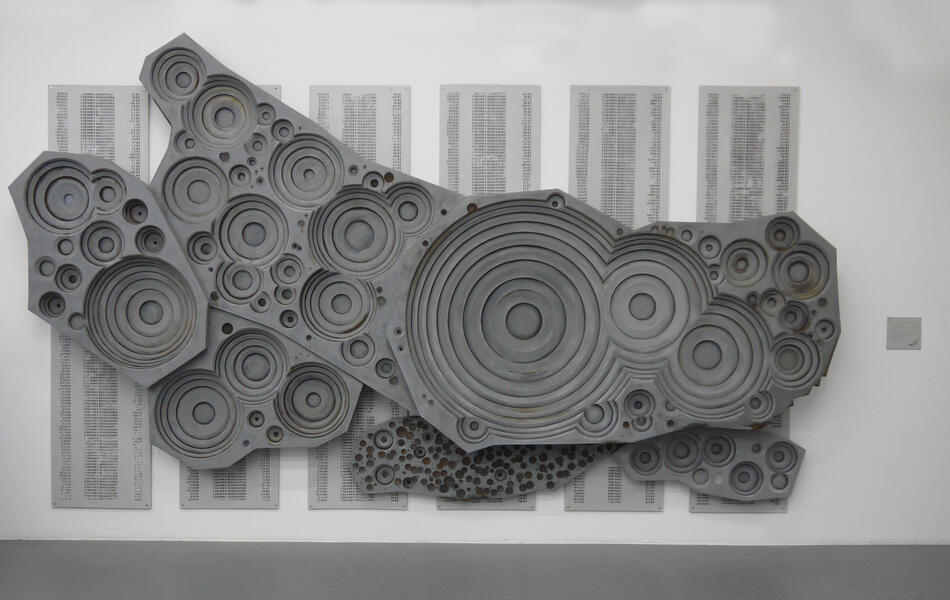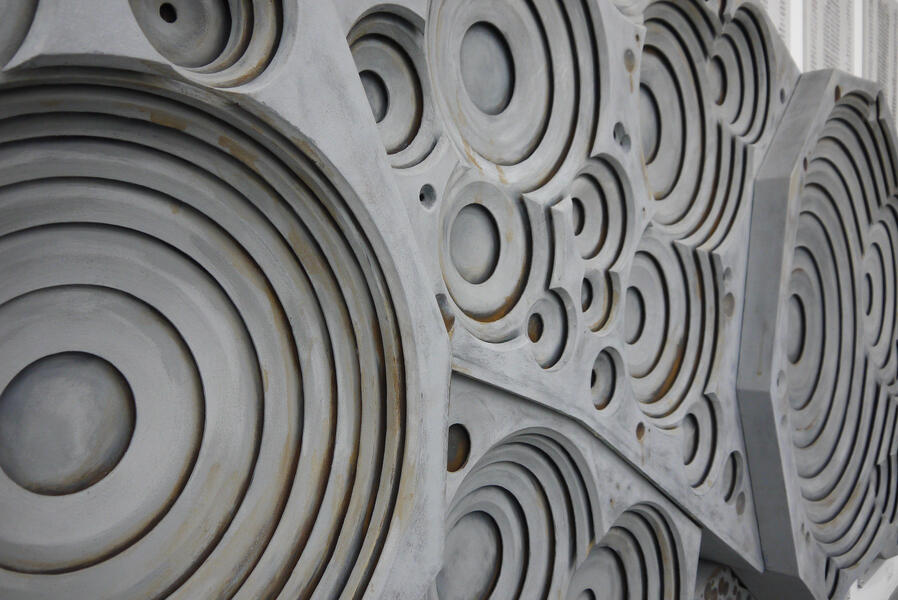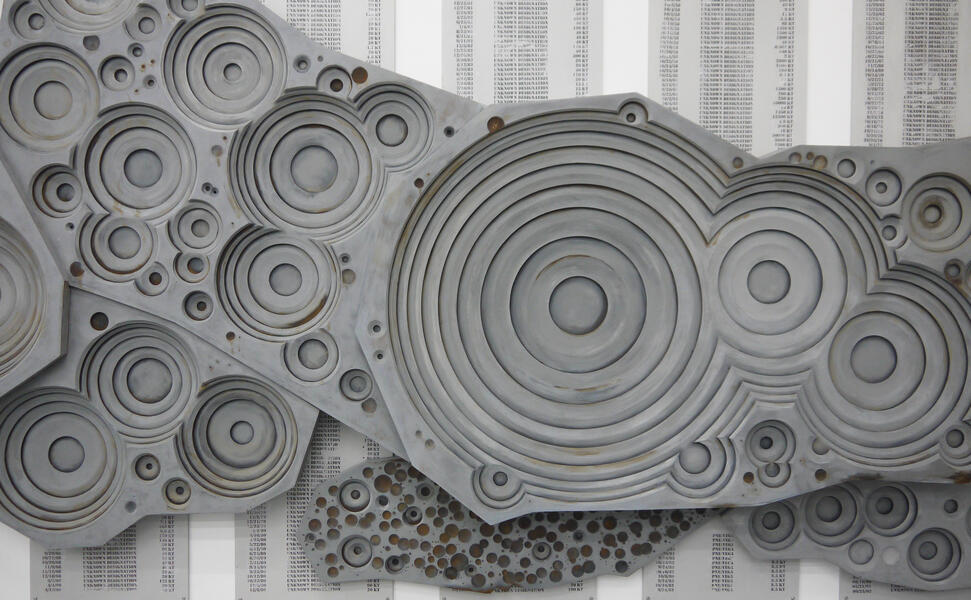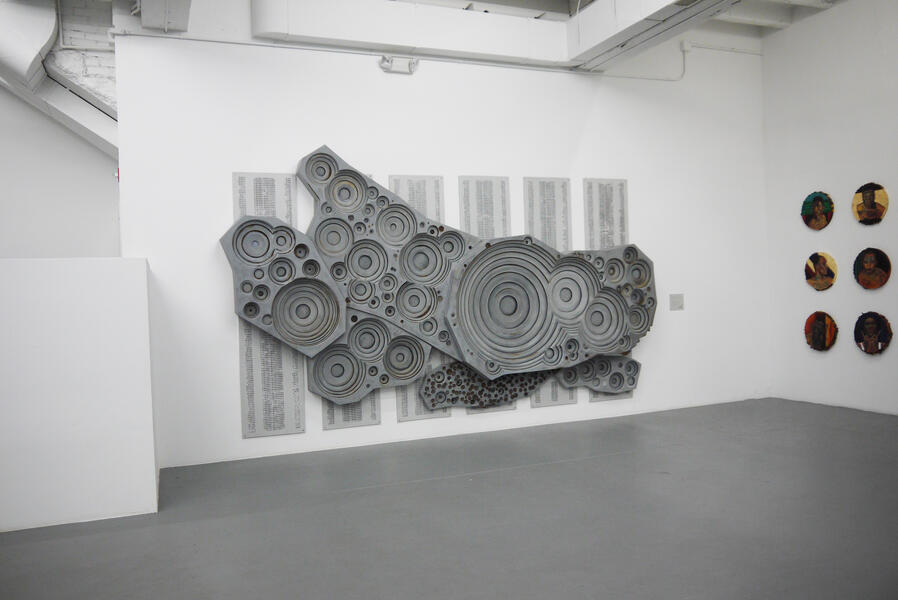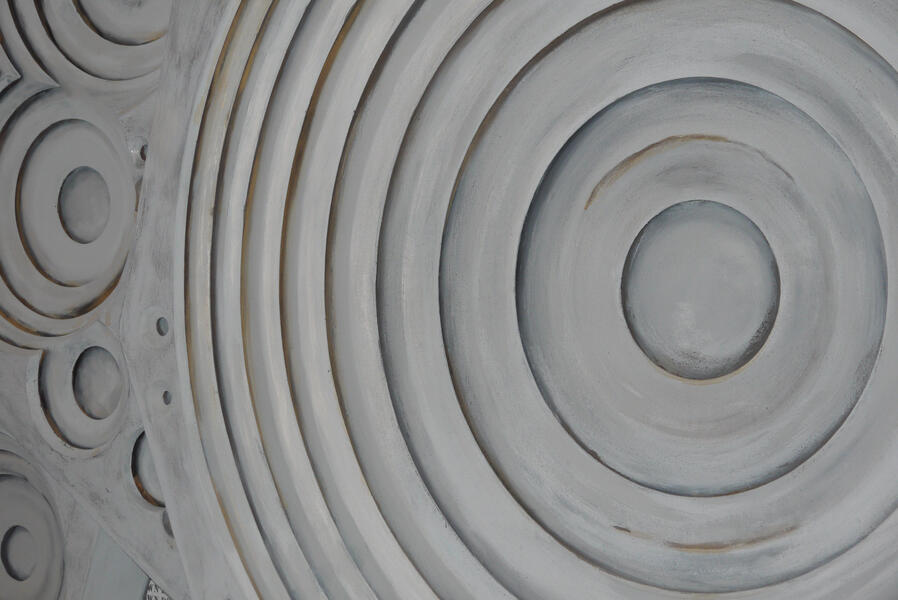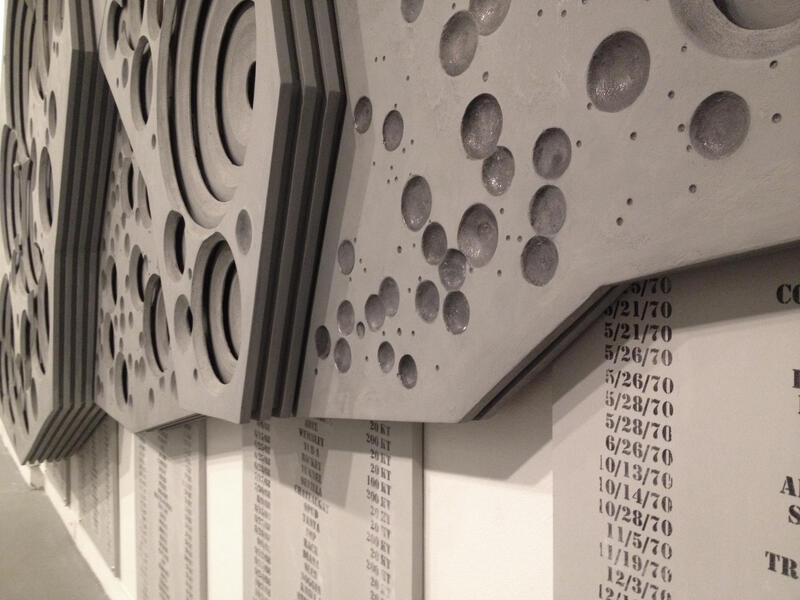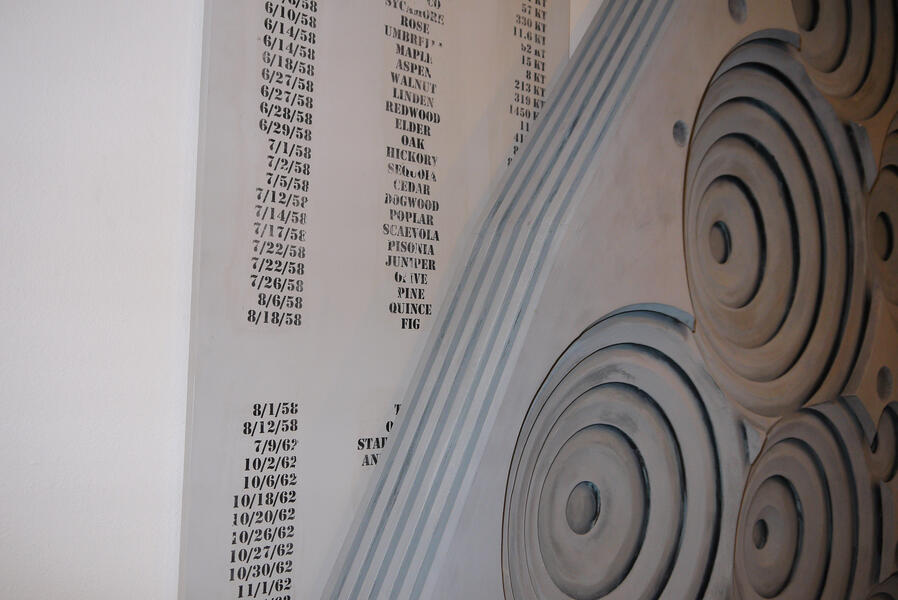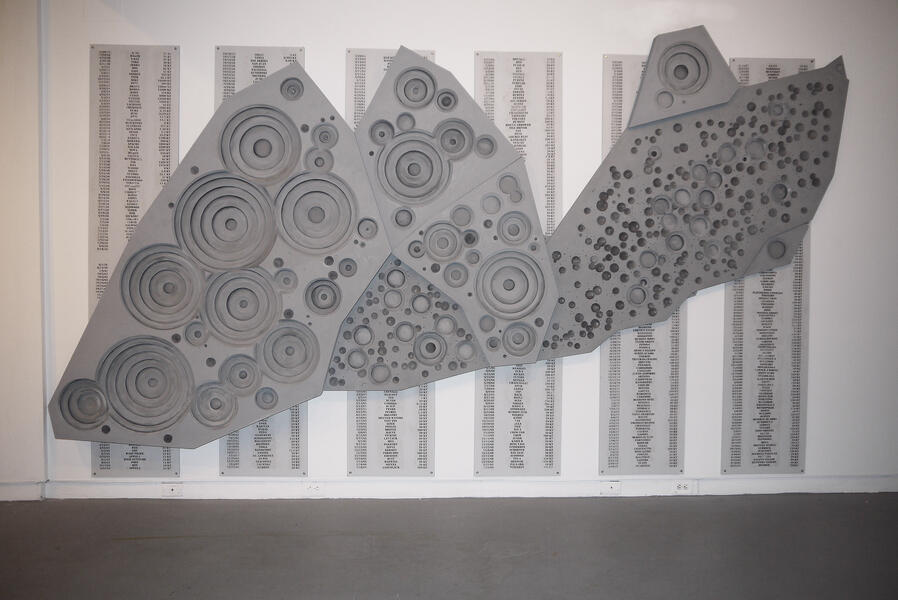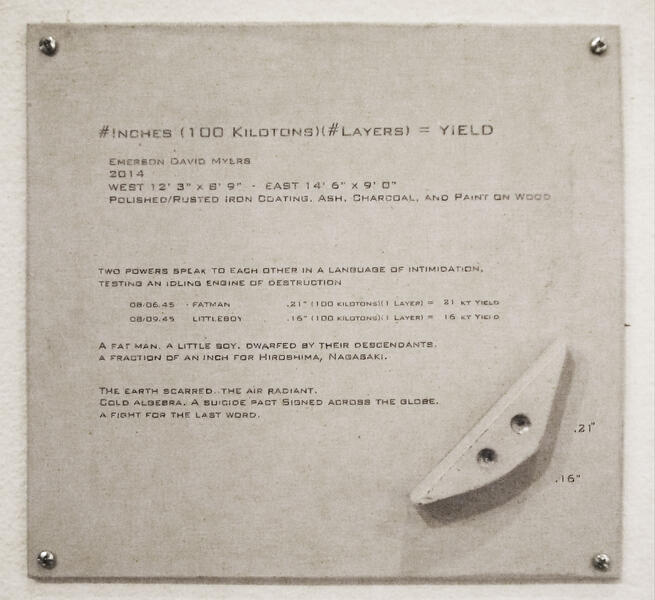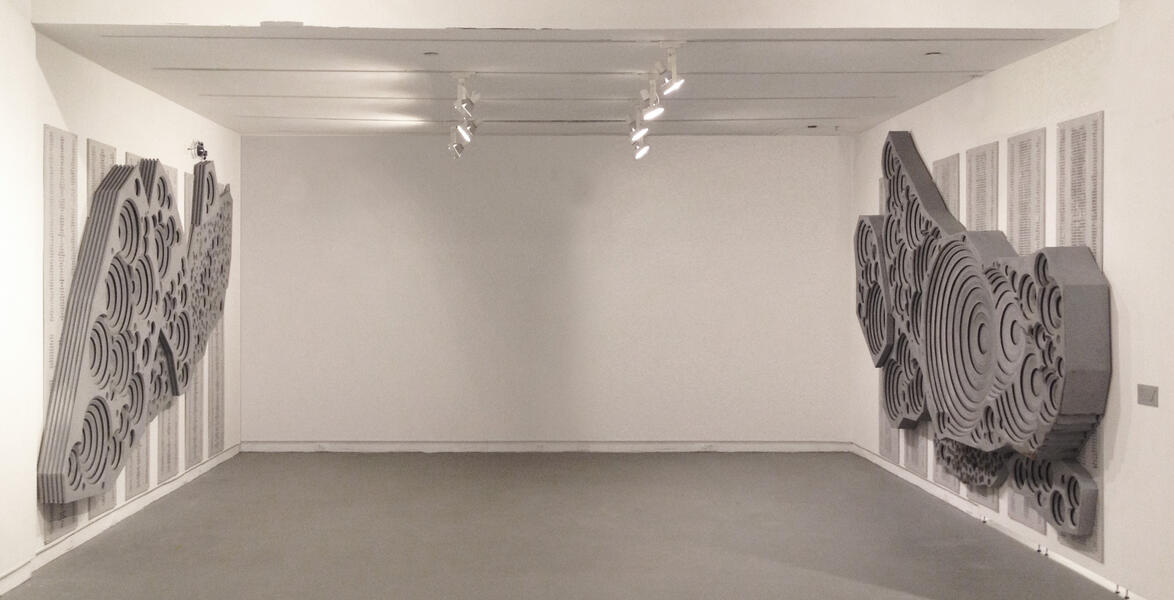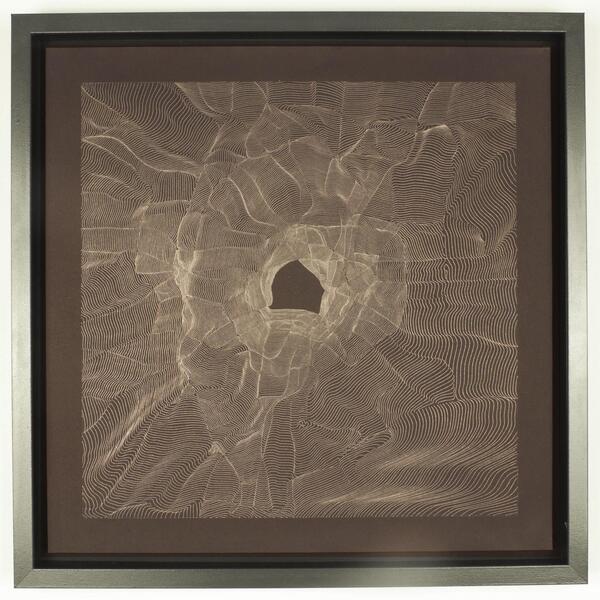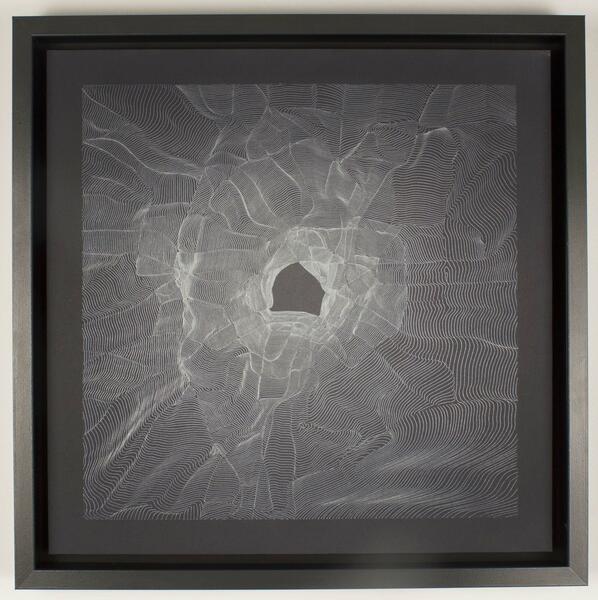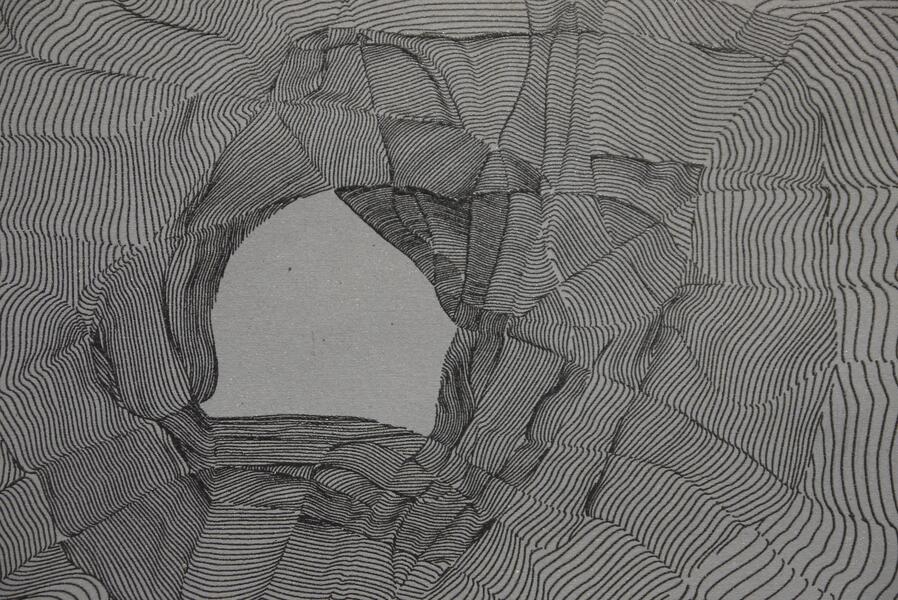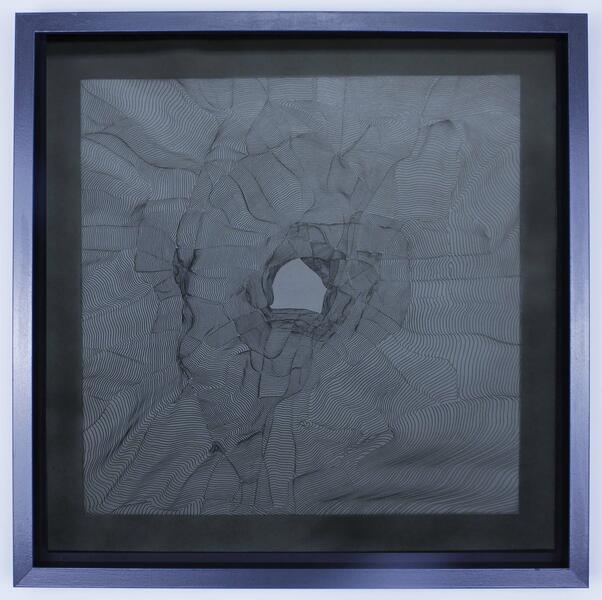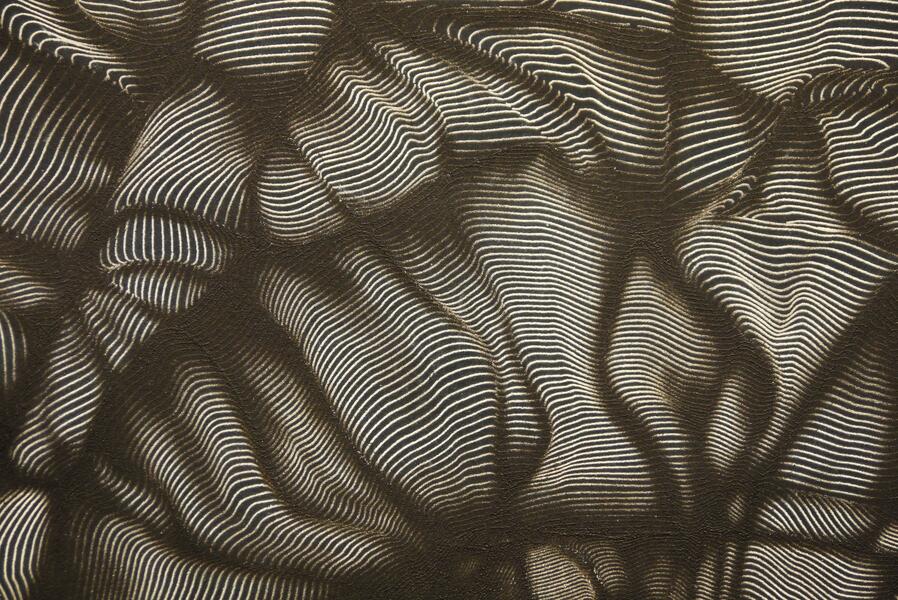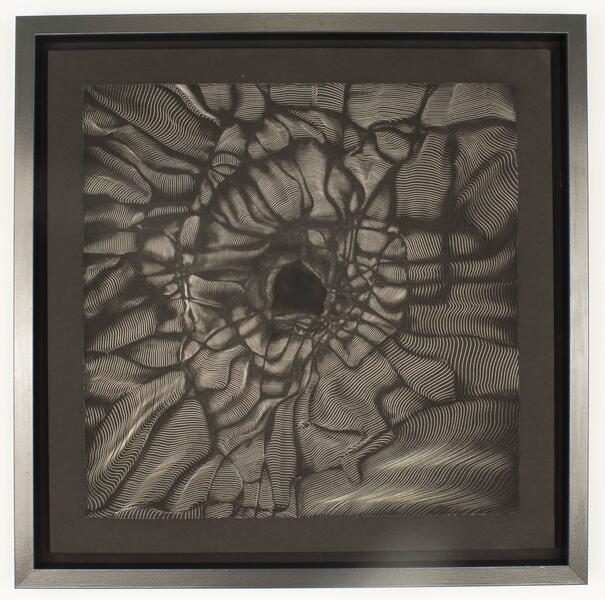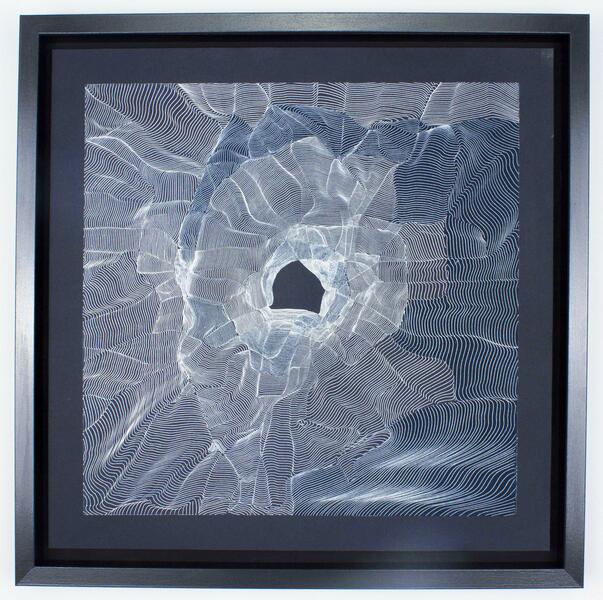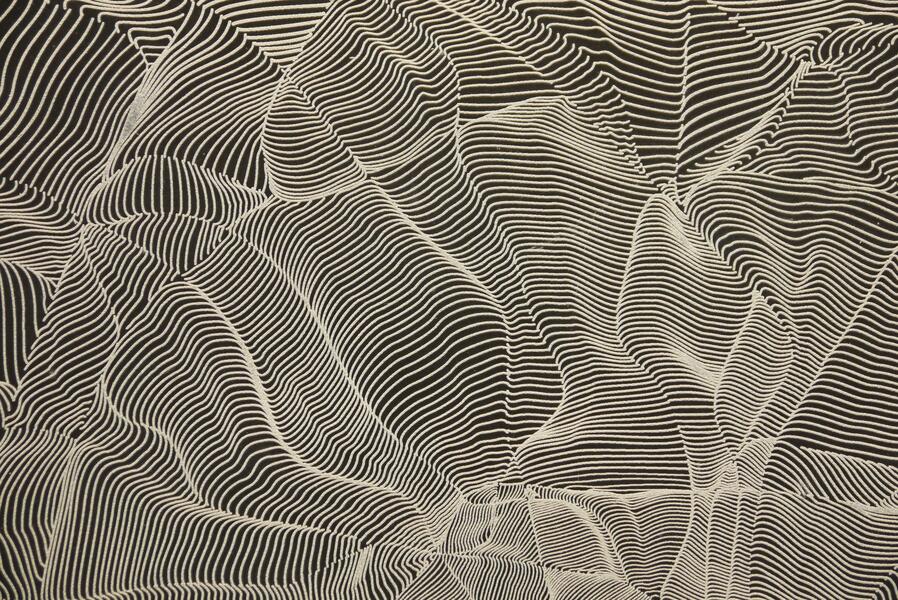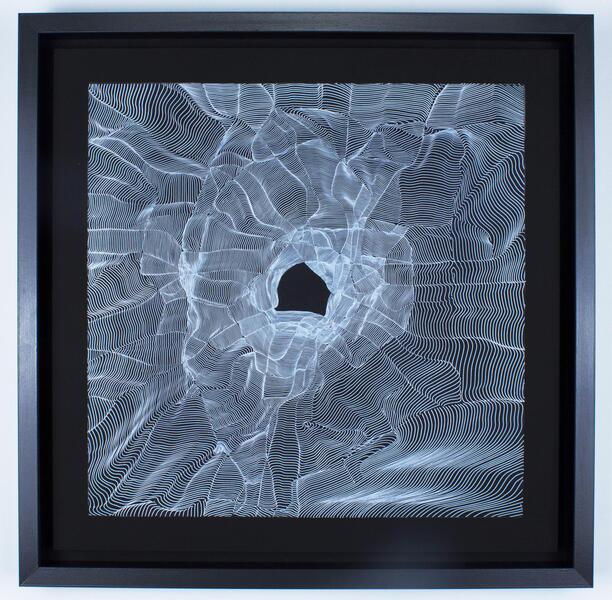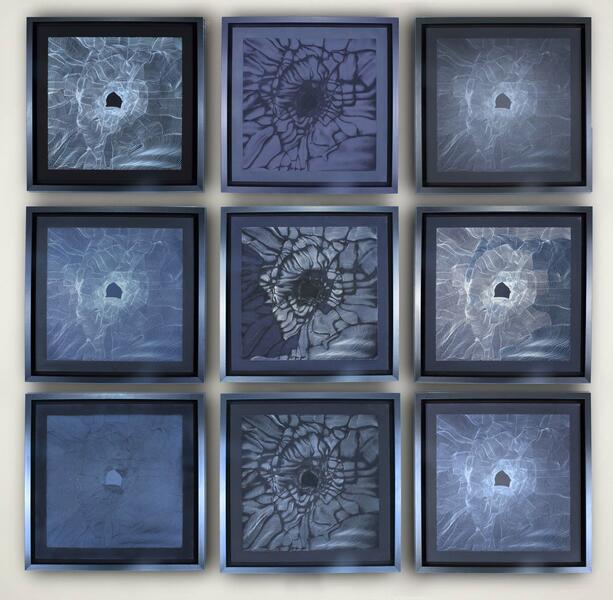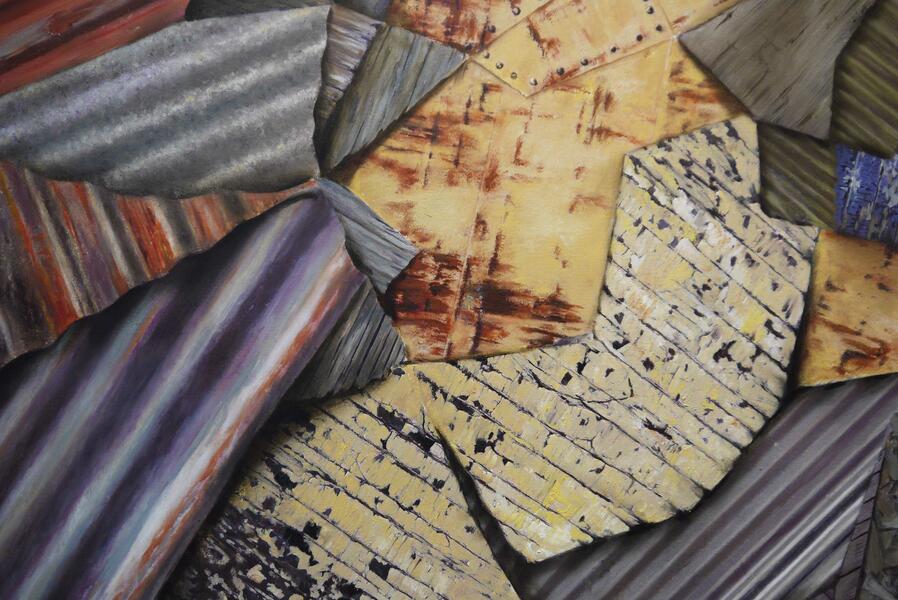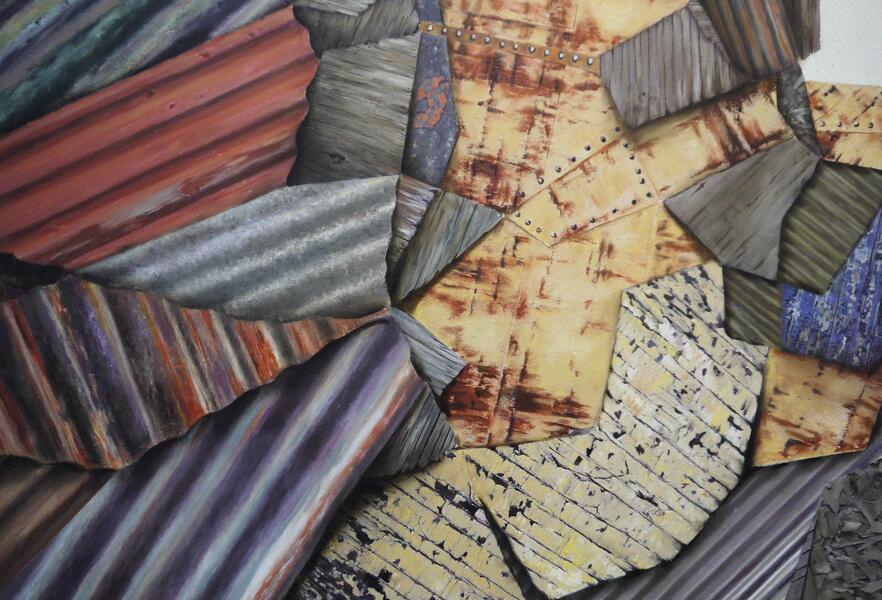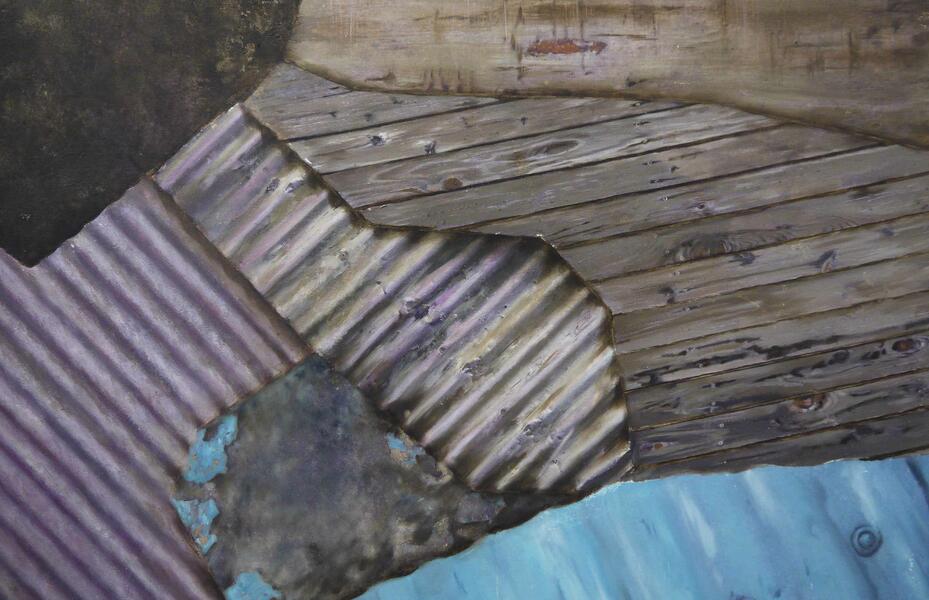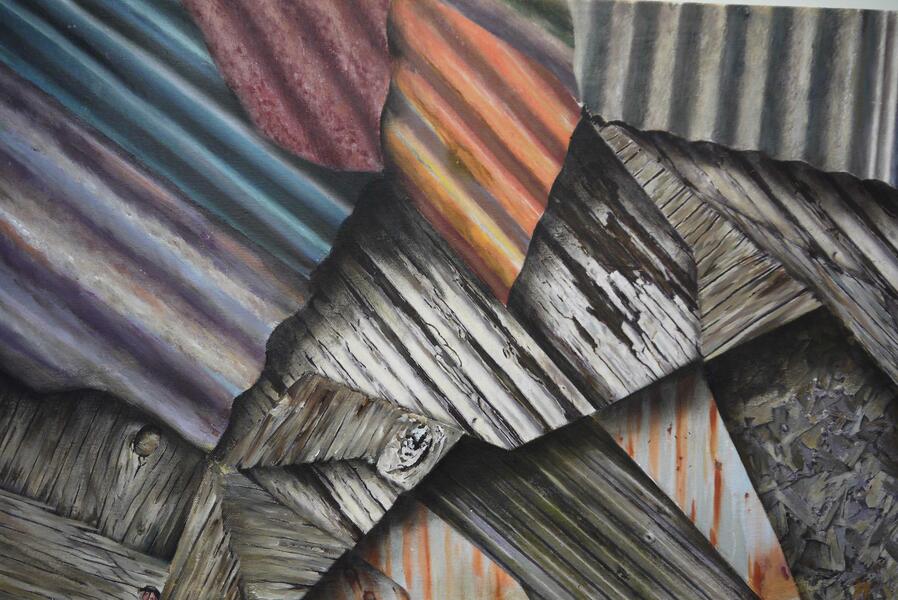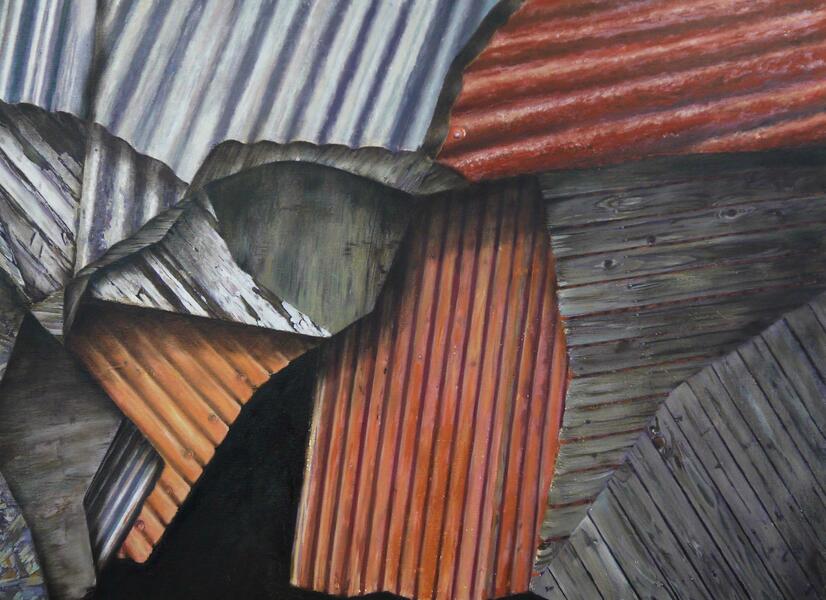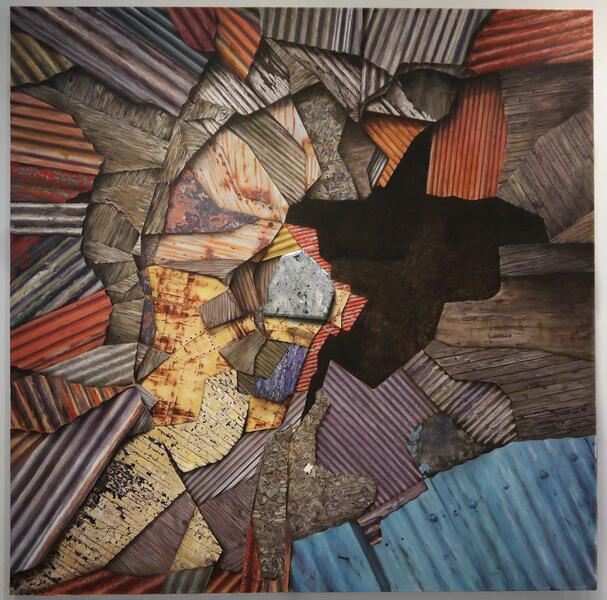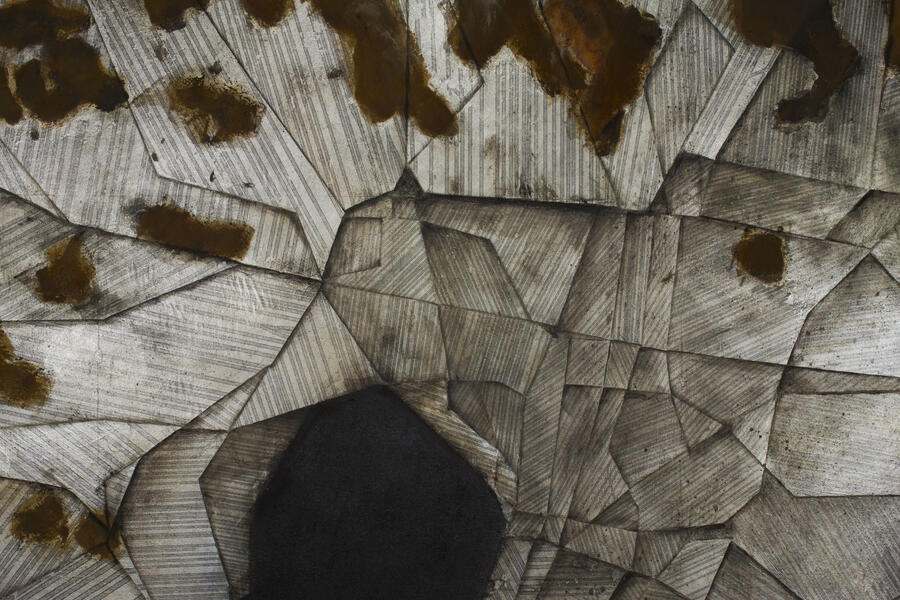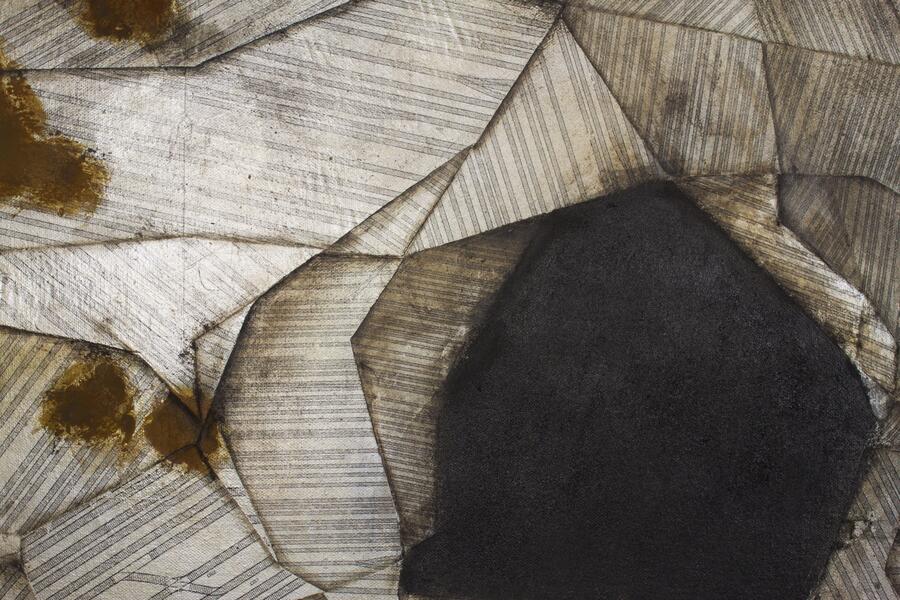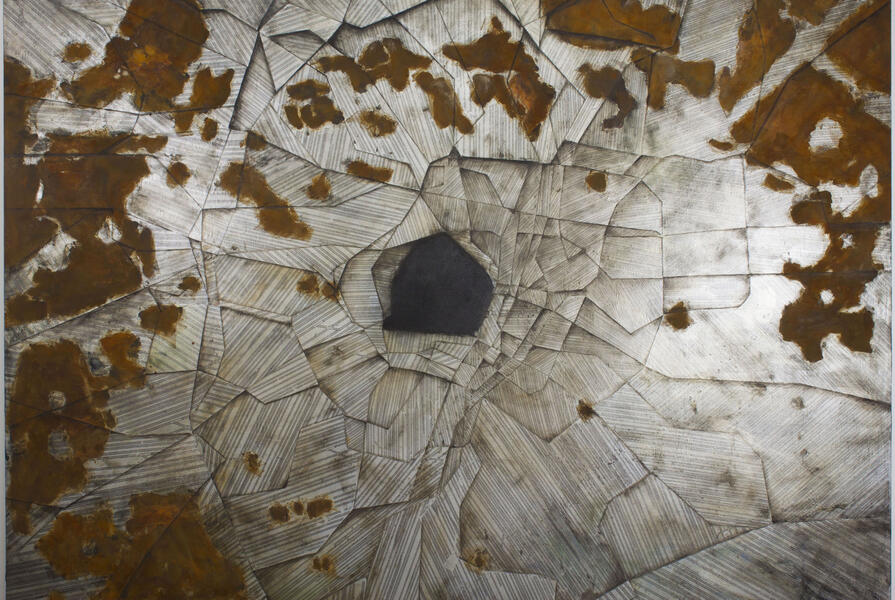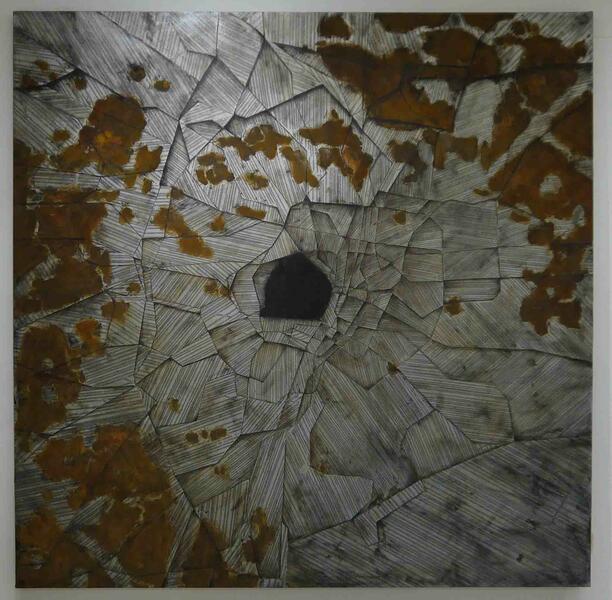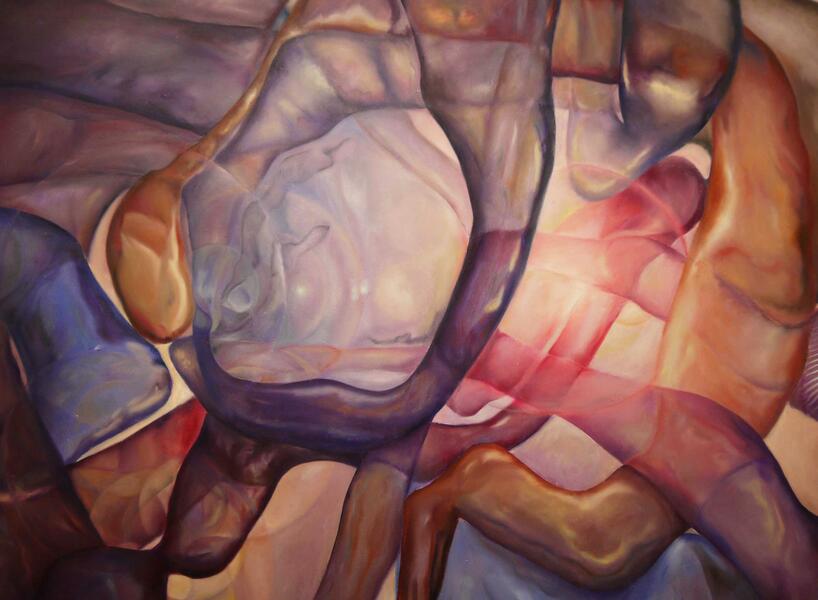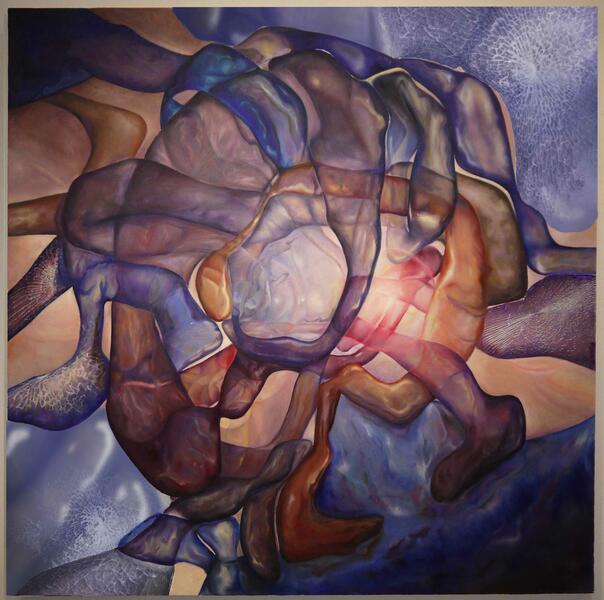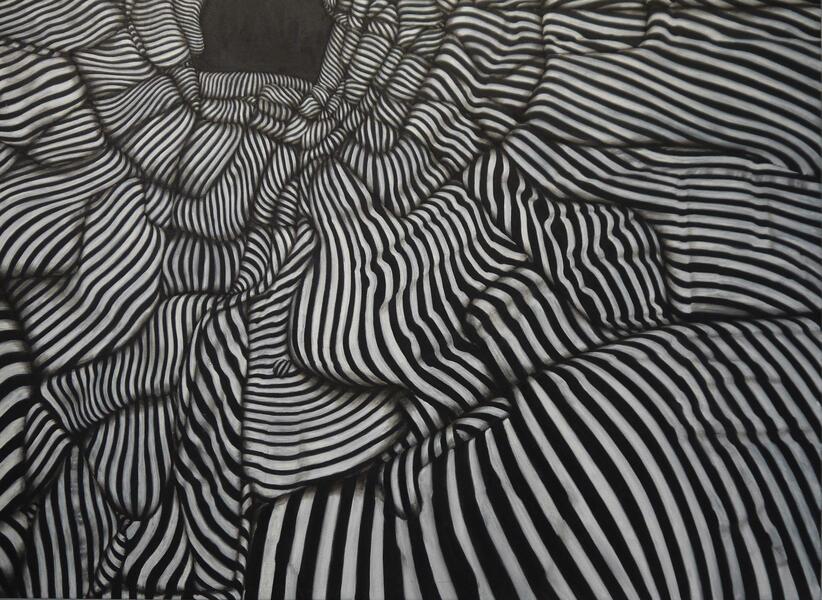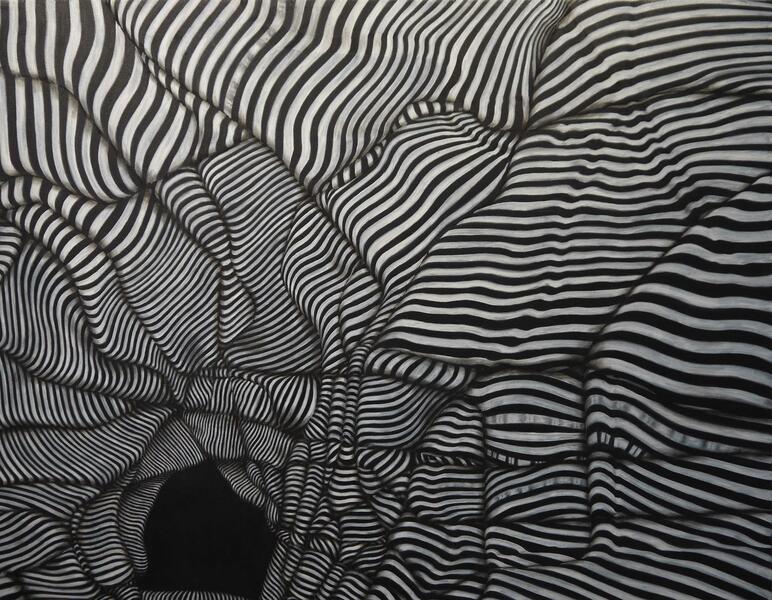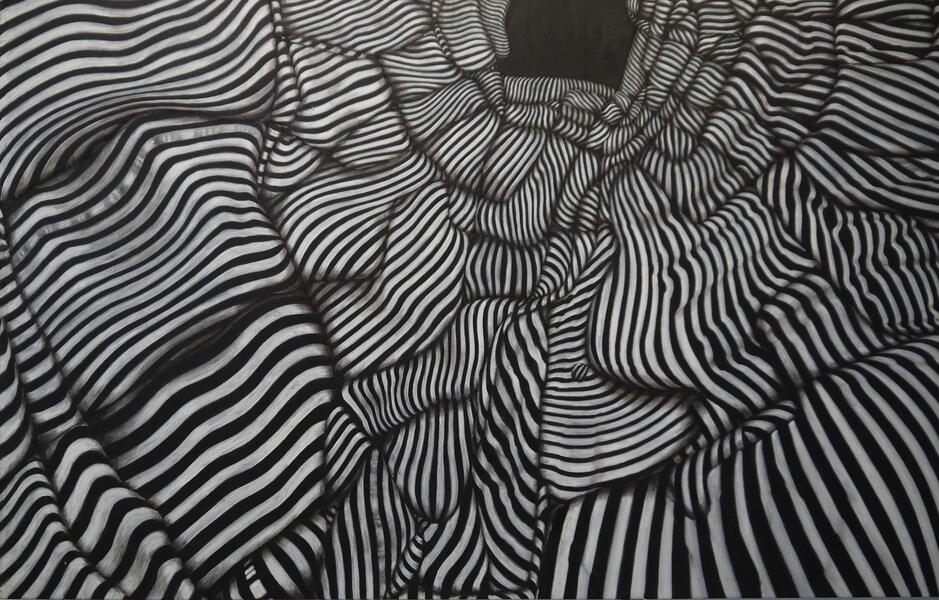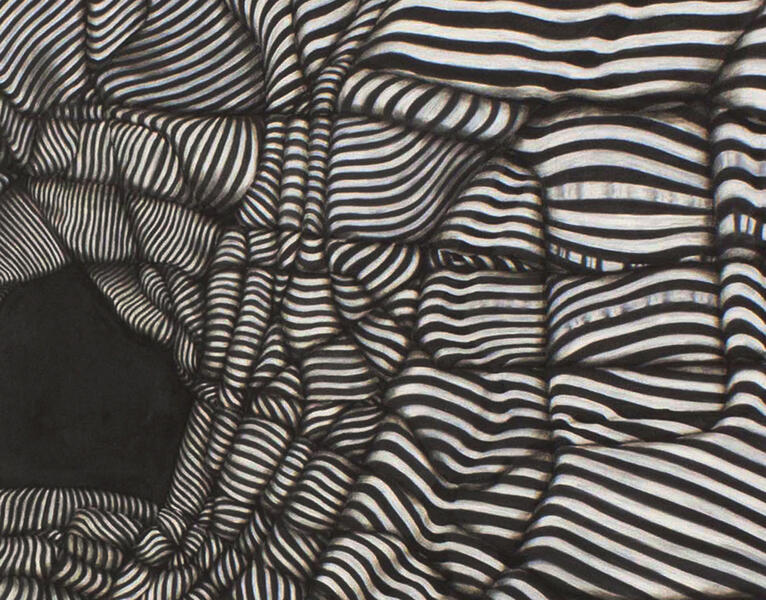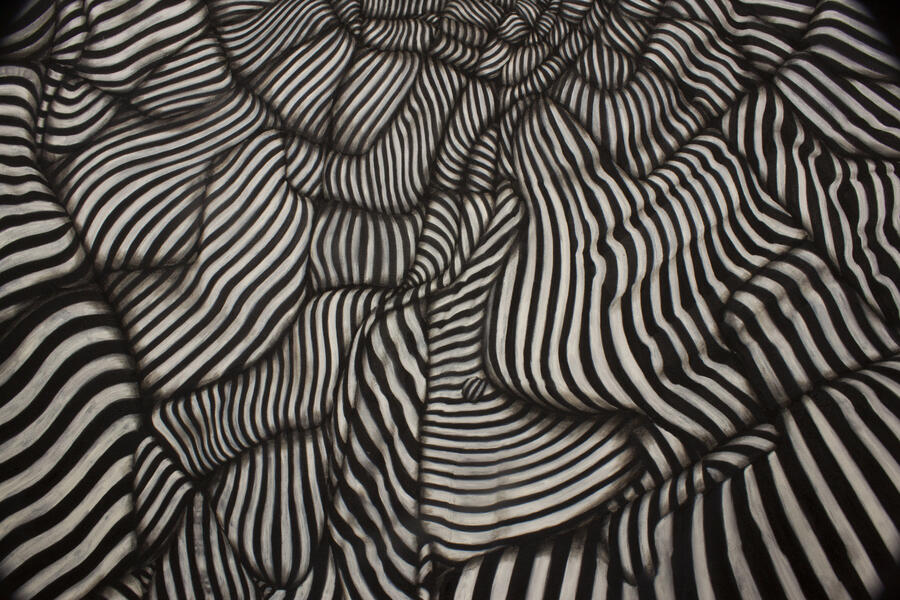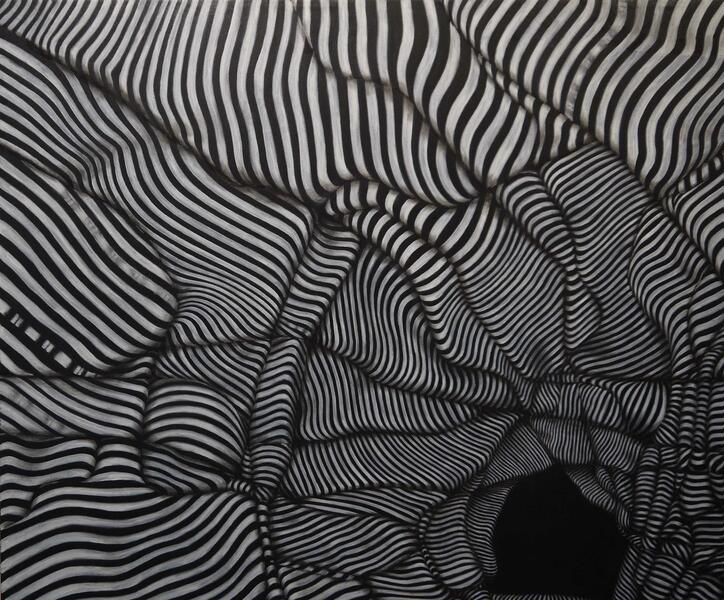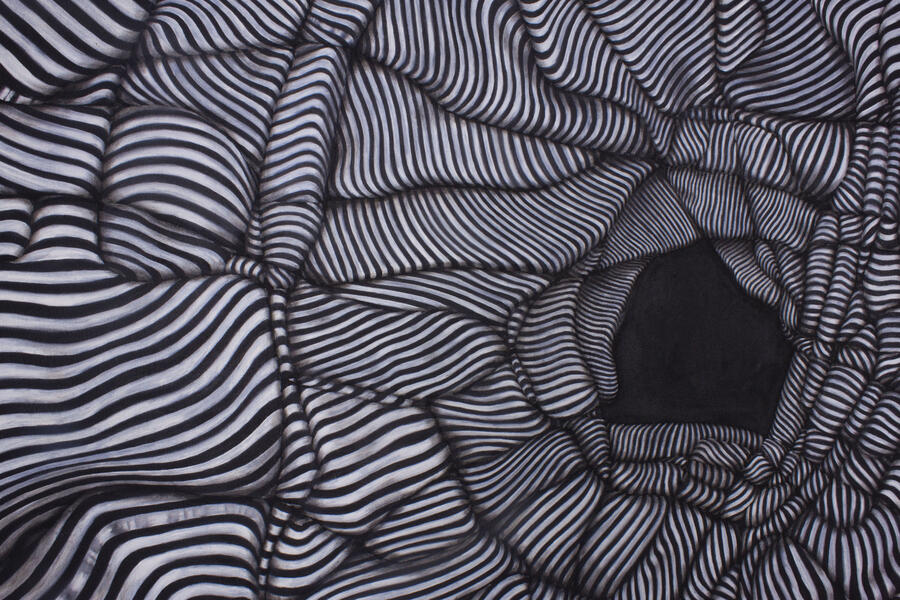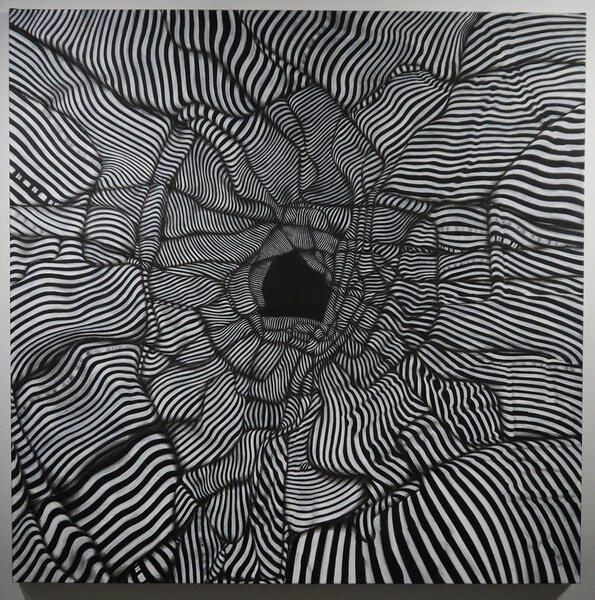About Emerson David
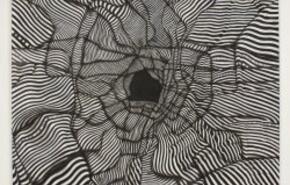
Emerson David Myers is a painter, sculptor, printmaker, digital artist, and educator who is currently living in the United States and Japan. He received his MFA in Interdisciplinary Studio Art from the Maryland Institute College of Art, and a Masters of Art Education from Boston University. His work focuses on socio-political issues, revolving around a continued and pressing desire to educate and inform his audience.
Most of his inspiration comes from his varied professional… more
Most of his inspiration comes from his varied professional… more
Jump to a project:
Gerrymandering
White and Silver Lithograph on Black Paper, 20" x 20"
When looking at a map of the world's time zones you do not find the expected, rigid structure dictated by the predictable turning of the earth. Instead, it is scarred by an extensively manipulated series of divisions, revealing how, in the most convoluted ways, nations refuse to share even the same definition of daylight as their rivals.
When looking at a map of the world's time zones you do not find the expected, rigid structure dictated by the predictable turning of the earth. Instead, it is scarred by an extensively manipulated series of divisions, revealing how, in the most convoluted ways, nations refuse to share even the same definition of daylight as their rivals.
#Inches (100 Kilotons)(#Layers)=YIELD
Two powers speak to each other in a language of intimidation,
testing an idling engine of destruction.
08/06/45 FATMAN .21” (100 kilotons)(1 Layer) = 21 kt Yield
08/09/45 LITTLEBOY .16” (100 kilotons)(1 Layer) = 16 kt Yield
A fat man, a little boy, dwarfed by their descendants.
A fraction of an inch for Hiroshima, Nagasaki.
The earth scarred, the air radiant.
Cold algebra. A suicide pact signed across the globe.
A fight for the last word.
These two sculptures present a scale representation of every nuclear test performed by NATO the USSR and China since the conception of the nuclear age. It reveals the staggering size of destruction, but moreover, it shows the way nuclear powers posture and communicate. These were not tests, but a language spoken across the globe. As the argument grew on, so did the size of the clouds.
testing an idling engine of destruction.
08/06/45 FATMAN .21” (100 kilotons)(1 Layer) = 21 kt Yield
08/09/45 LITTLEBOY .16” (100 kilotons)(1 Layer) = 16 kt Yield
A fat man, a little boy, dwarfed by their descendants.
A fraction of an inch for Hiroshima, Nagasaki.
The earth scarred, the air radiant.
Cold algebra. A suicide pact signed across the globe.
A fight for the last word.
These two sculptures present a scale representation of every nuclear test performed by NATO the USSR and China since the conception of the nuclear age. It reveals the staggering size of destruction, but moreover, it shows the way nuclear powers posture and communicate. These were not tests, but a language spoken across the globe. As the argument grew on, so did the size of the clouds.
Salary Man II
n this series I have combined the use of the language of mapping, optical contour lines reminiscent of topographic lines, and the mapped wireframe structure of a cities phenomenal train system to speak to my experience with place. Each work is guided compositionally by the city's infrastructure, and thematically by the city itself, its people, and its culture.
Shanty Town
All infrastructure, no matter how stable it may seem, has the potential to be reduced to rubble. This is Tokyo manufactured from building remnants, reminiscent of a shanty structure. The transportation system continues to guide the shapes and forms of the composition. The open hole, revealing the earth below, is the area that was most affected by the horrible earthquake and fire of 1923. The quiet palace, removed from all destruction, is depicted as an unshaken concrete block.
Fracture
60" x 60", Oil, Ink and Acrylic on Canvas
In 1923, long before many of these rail lines existed, Tokyo experienced a devastating earthquake that resulted in widespread fire and destruction. Continuing to use the language of maps, this work combines the guided composition of the city’s subway and rail system with a record of that system’s one-time collapse. The lowest, recessed areas of this crumpled steel shape denotes the part of the city that suffered the most during the 1923 earthquake. The areas marked with rust patches signify the most vulnerable parts of the city today if faced with a similar natural disaster.
In 1923, long before many of these rail lines existed, Tokyo experienced a devastating earthquake that resulted in widespread fire and destruction. Continuing to use the language of maps, this work combines the guided composition of the city’s subway and rail system with a record of that system’s one-time collapse. The lowest, recessed areas of this crumpled steel shape denotes the part of the city that suffered the most during the 1923 earthquake. The areas marked with rust patches signify the most vulnerable parts of the city today if faced with a similar natural disaster.
Fragile
60" x 60" Oil on Canvas
Drawing on the structure of the Tokyo transit system to lay out the composition, this image reflects the systems complexity, as well as its fragility. Aside from marking rail lines with the outer edges of the glass structure, the cracked areas reflect the most vulnerable parts of Tokyo, and the bright spot marks the district that was extensively destroyed by fire during the 1923 earthquake.
Drawing on the structure of the Tokyo transit system to lay out the composition, this image reflects the systems complexity, as well as its fragility. Aside from marking rail lines with the outer edges of the glass structure, the cracked areas reflect the most vulnerable parts of Tokyo, and the bright spot marks the district that was extensively destroyed by fire during the 1923 earthquake.
Commute I
60" x 60" Oil on Canvas
Compositionally guided by Tokyo's vast train system, the painting vibrates with rhythmic Op Art energy. As always, I include the empty core, the imperial palace. After 8 years there, I see a family isolated from Japanese culture and politics, a static symbol of history, the discussed, and the taboo.
Compositionally guided by Tokyo's vast train system, the painting vibrates with rhythmic Op Art energy. As always, I include the empty core, the imperial palace. After 8 years there, I see a family isolated from Japanese culture and politics, a static symbol of history, the discussed, and the taboo.
Generation Gap
60" x 60", Oil and Acrylic on Canvas
I feel that all of my work regarding Tokyo must be represented by a canvas crowded with imagery, providing something from every angle, capturing the horror vacui present in the city itself. Within this ‘fear of emptiness,’ I have attempted to depict Tokyo’s lush tapestry of varied personalities. Japan is a nation of contradictions, one of the most notable being tensions between generations. Here, surrounding the "empty core", as Roland Barths called the isolated imperial palace, is the more lively and garish part of the city where the consumer driven interests of the youth are surrounded by the more mature cultural concerns of the passing generation.
I feel that all of my work regarding Tokyo must be represented by a canvas crowded with imagery, providing something from every angle, capturing the horror vacui present in the city itself. Within this ‘fear of emptiness,’ I have attempted to depict Tokyo’s lush tapestry of varied personalities. Japan is a nation of contradictions, one of the most notable being tensions between generations. Here, surrounding the "empty core", as Roland Barths called the isolated imperial palace, is the more lively and garish part of the city where the consumer driven interests of the youth are surrounded by the more mature cultural concerns of the passing generation.
-
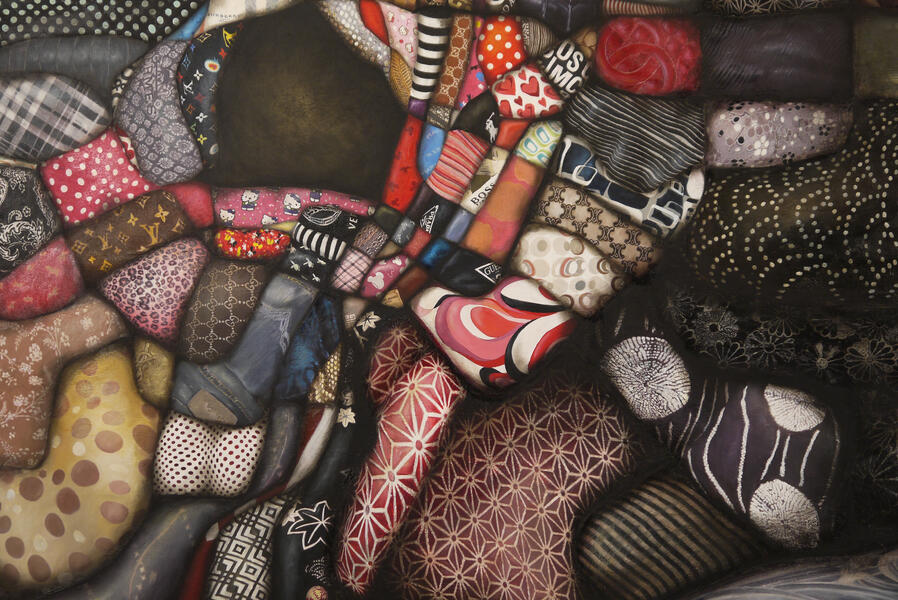 Generation Gap
Generation Gap -
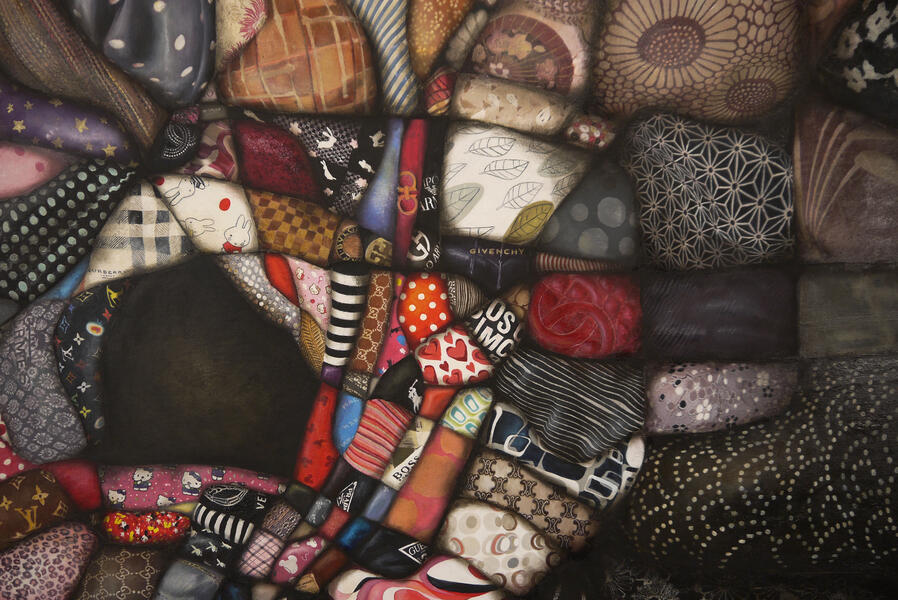 Generation Gap
Generation Gap -
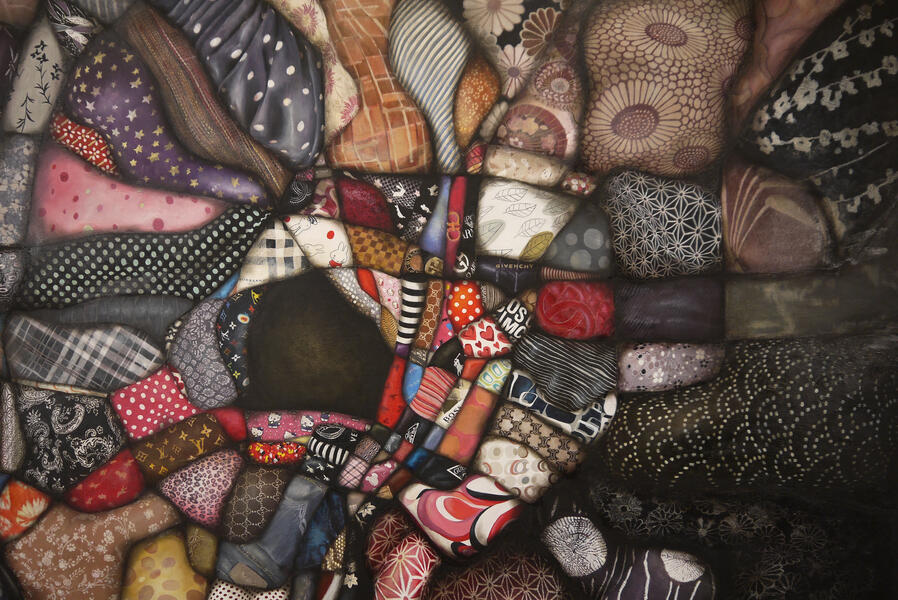 Generation Gap
Generation Gap -
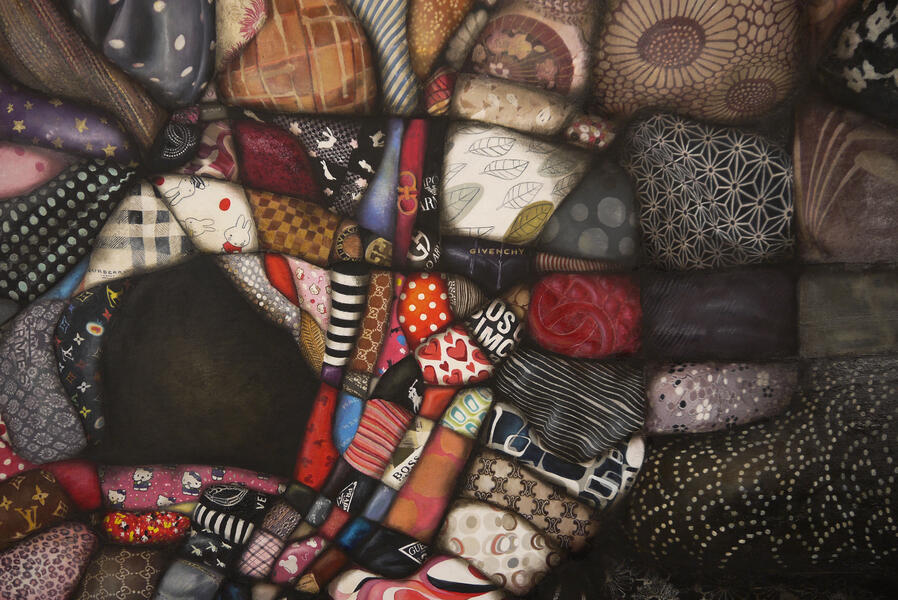 Generation Gap
Generation Gap -
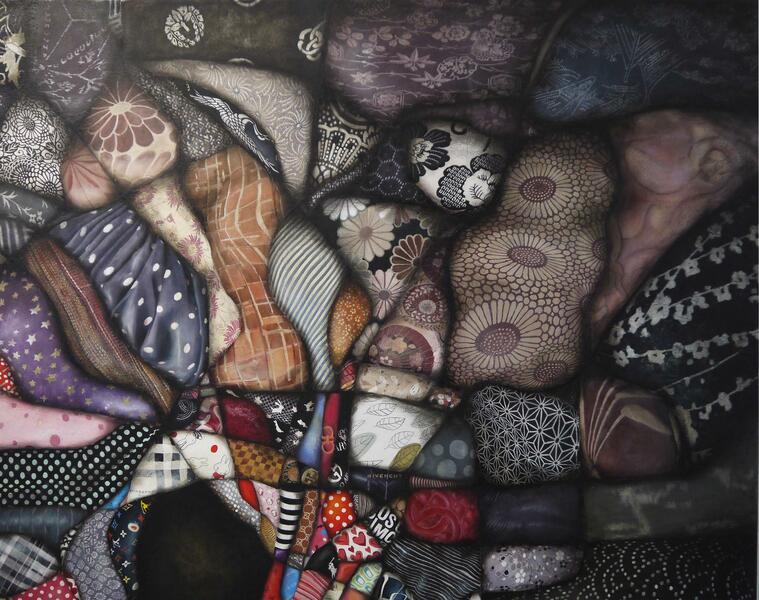 Generation Gap
Generation Gap -
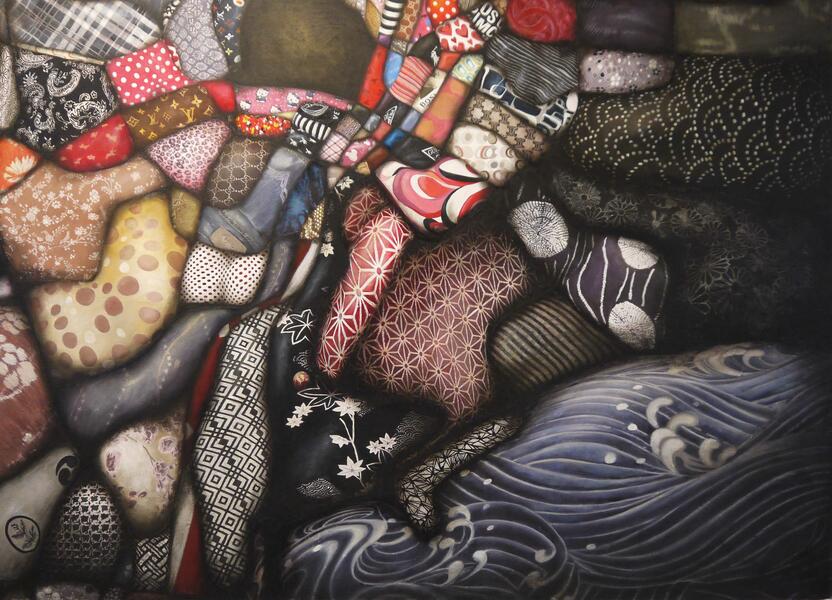 Generation Gap
Generation Gap -
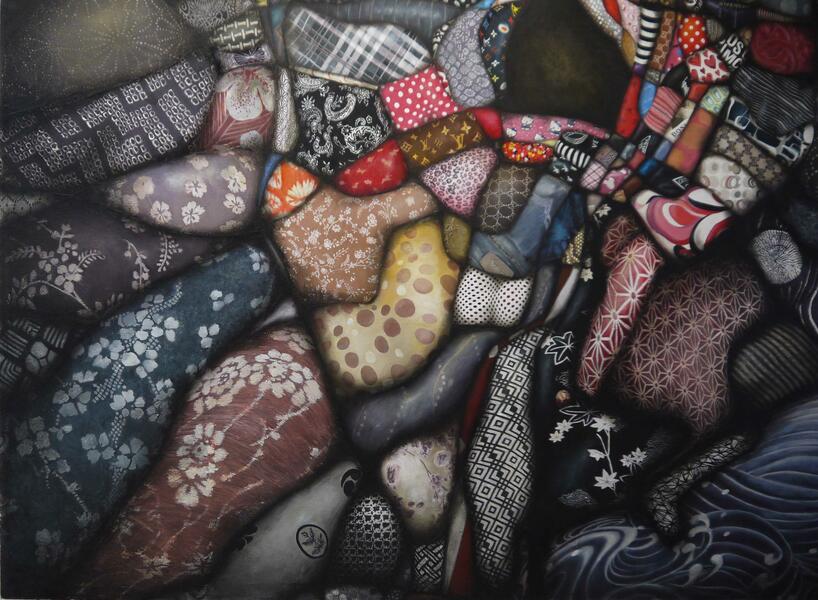 Generation Gap
Generation Gap -
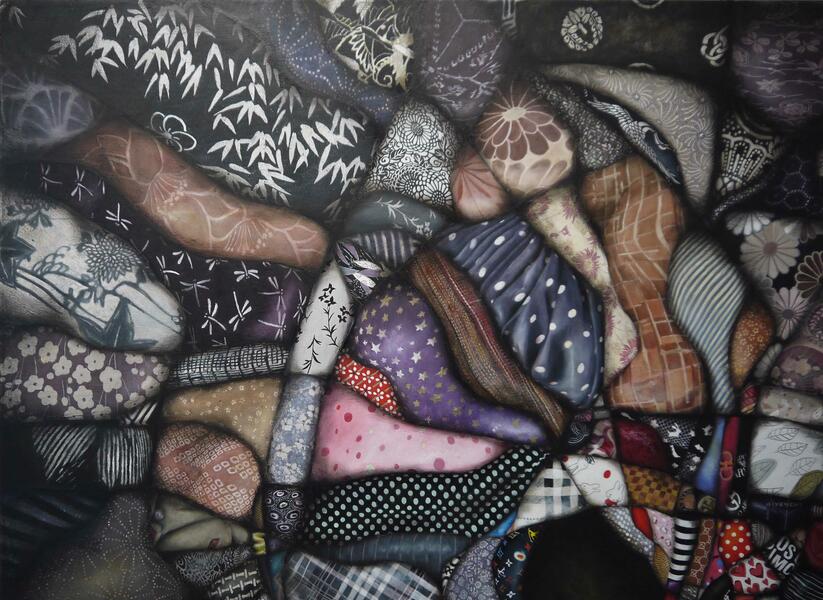 Generation Gap
Generation Gap -
 Generation GapThe composition of this series is based on the transit map of Tokyo. I can't help but be drawn to this system. The is the largest system in the world by far. Its largest station, Shinjuku (see this overlay I added for explanation) processes more people than the entire New York system combined.
Generation GapThe composition of this series is based on the transit map of Tokyo. I can't help but be drawn to this system. The is the largest system in the world by far. Its largest station, Shinjuku (see this overlay I added for explanation) processes more people than the entire New York system combined. -
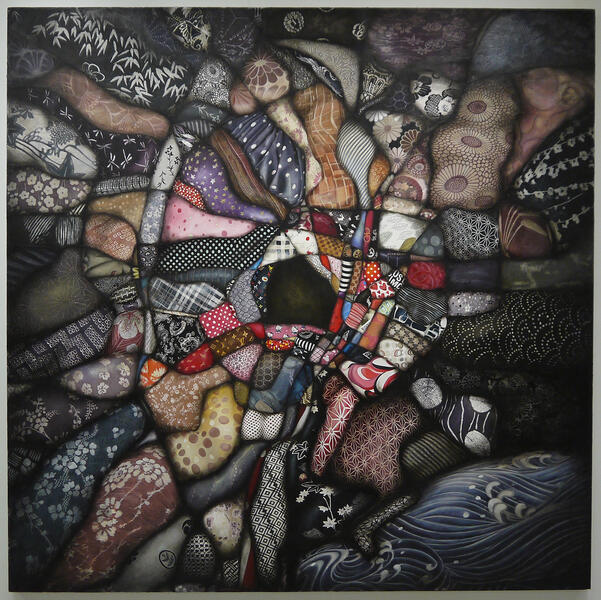 Generation Gap
Generation Gap
